Thyroxine Quantification by Using Plasmonic Nanoparticles as SERS Substrates
Abstract
1. Introduction
2. Materials and Methods
2.1. Au NPs Synthesis
2.2. Ag NPs Synthesis
2.3. Preparation of SERS Substrates of Au and Ag NPs
2.4. Deposition of T4 on Different Substrates
SERS Substrate Preparation
2.5. Equipment
2.6. Theoretical-Numerical Calculations
3. Results and Discussion
4. Conclusions
Supplementary Materials
Author Contributions
Funding
Institutional Review Board Statement
Informed Consent Statement
Data Availability Statement
Acknowledgments
Conflicts of Interest
References
- Hiller-Sturmhöfel, S.; Bartke, A. The endocrine system: An overview. Alcohol Health Res. World 1998, 22, 153–164. [Google Scholar]
- Silva, J.F.; Ocarino, N.M.; Serakides, R. Thyroid hormones and female reproduction. Biol. Reprod. 2018, 99, 907–921. [Google Scholar] [CrossRef]
- Shokripour, M.; Imanieh, M.H.; Garayemi, S.; Omidifar, N.; Shirazi Yeganeh, B.; Althabhawee, F. Thyroid stimulating hormone, T3 and T4 population-based reference range and children prevalence of thyroid dysfunction: First report from South of Iran. Iran J. Pathol. 2022, 17, 427–434. [Google Scholar] [CrossRef] [PubMed]
- Thumvijit, T.; Supawat, B.; Wattanapongpitak, S.; Kothan, S.; Tungjai, M. Effect of iodinated radiographic contrast media on radioimmunoassay for measuring thyroid hormones. Appl. Radiat. Isot. 2022, 185, 110261. [Google Scholar] [CrossRef]
- UCLA. Health Endocrine Surgery Normal Thyroid Hormone LEVELS. Available online: https://www.uclahealth.org/medical-services/surgery/endocrine-surgery/conditions-treated/thyroid/normal-thyroid-hormone-levels (accessed on 10 July 2023).
- Martino, E.; Bambini, G.; Bartalena, L.; Mammoli, C.; Aghni-Lombardi, F.; Baschierli, L.; Pinchera, A. Human serum thyrotrophin measurement by ultrasensitive immunoradiometric assay as a first-line test in the evaluation of thyroid function. Clin. Endocrinol. 1986, 24, 141–148. [Google Scholar] [CrossRef]
- Fritz, K.S.; Wilcox, R.B.; Nelson, J.C. A Direct free thyroxine (T4) immunoassay with the characteristics of a total T4 immunoassay. Clin. Chem. 2007, 53, 911–915. [Google Scholar] [CrossRef] [PubMed]
- Ross, D.S. Serum thyroid-stimulating hormone measurement for assessment of thyroid function and disease. Endocrinol. Metab. Clin. N. Am. 2001, 30, 245–264. [Google Scholar] [CrossRef] [PubMed]
- Maes, M.; Meltzer, H.Y.; Cisyns, P.; Suy, E.; Schotte, C. An evaluation of basal hypothalamic-pituitary-thyroid axis function in depression: Results of a large-scaled and controlled study. Psychoneuroendocrinology 1993, 18, 607–620. [Google Scholar] [CrossRef] [PubMed]
- Neu, V.; Bielow, C.; Gostomski, I.; Wintringer, R.; Braun, R.; Reinert, K.; Schneider, P.; Stuppner, H.; Huber, C.G. Rapid and comprehensive impurity profiling of synthetic thyroxine by ultrahigh-performance liquid chromatography−high-resolution mass spectrometry. Anal. Chem. 2013, 85, 3309–3317. [Google Scholar] [CrossRef]
- Ackermans, M.T.; Klieverik, L.P.; Ringeling, P.; Endert, E.; Kalsbeek, A.; Fliers, E. An online solid-phase extraction–liquid chromatography–tandem mass spectrometry method to study the presence of thyronamines in plasma and tissue and their putative conversion from 13C6-thyroxine. J. Endocrinol. 2010, 206, 327–334. [Google Scholar] [CrossRef]
- Ackermans, M.T.; Kettelarij-Haas, Y.; Boelen, A.; Endert, E. Determination of thyroid hormones and their metabolites in tissue using SPE UPLC-tandem MS. Biomed. Chromatogr. 2012, 26, 485–490. [Google Scholar] [CrossRef] [PubMed]
- Luna, L.G.; Coady, K.; McFadden, J.R.; Markham, D.A.; Bartels, M.J. Quantification of total thyroxine in plasma from xenopus laevis. J. Anal. Toxicol. 2013, 37, 326–336. [Google Scholar] [CrossRef] [PubMed]
- Kunisue, T.; Fisher, J.W.; Fatuyi, B.; Kannan, K. A method for the analysis of six thyroid hormones in thyroid gland by liquid chromatography–tandem mass spectrometry. J. Chromatogr. B 2010, 878, 1725–1730. [Google Scholar] [CrossRef] [PubMed]
- Kunisue, T.; Fisher, J.W.; Fatuyi, B.; Kannan, K. Determination of six thyroid hormones in the brain and thyroid gland using isotope-dilution liquid Chromatography/Tandem Mass Spectrometry. Anal. Chem. 2011, 83, 417–424. [Google Scholar] [CrossRef] [PubMed]
- Orlov, A.V.; Znoyko, S.L.; Pushkarev, A.V.; Mochalova, E.N.; Guteneva, N.V.; Lunin, A.V.; Nikitin, M.P.; Nikitin, P.I. Data on characterization and validation of assays for ultrasensitive quantitative detection of small molecules: Determination of free thyroxine with magnetic and interferometric methods. Data Br. 2018, 21, 1603–1611. [Google Scholar] [CrossRef]
- Bikkarolla, S.K.; McNamee, S.E.; Vance, P.; McLaughlin, J. High-sensitive detection and quantitative analysis of thyroid-stimulating hormone using gold-nanoshell-based lateral flow immunoassay device. Biosensors 2022, 12, 182. [Google Scholar] [CrossRef]
- Kim, K.; Han, D.K.; Choi, N.; Kim, S.H.; Joung, Y.; Kim, K.; Ho, N.T.; Joo, S.W.; Choo, J. Surface-enhanced Raman scattering-based dual-flow lateral flow assay sensor for the ultrasensitive detection of the thyroid-stimulating hormone. Anal. Chem. 2021, 93, 6673–6681. [Google Scholar] [CrossRef]
- David, M.; Serban, A.; Enache, T.E.; Florescu, M. Electrochemical quantification of levothyroxine at disposable screen-printed electrodes. J. Electroanal. Chem. 2022, 911, 116240. [Google Scholar] [CrossRef]
- Karim, P.; Gholamin, D.; Johari-Ahar, M. Electrochemical immunoassay for one-pot detection of thyroxin (T4) and thyroid-stimulating hormone (TSH) using magnetic and Janus nanoparticles. Anal. Bioanal. Chem. 2023, 415, 4741–4751. [Google Scholar] [CrossRef]
- Saxena, R.; Srivastava, S. A sensitive and one-step quantification of thyroid stimulating hormone using nanobiosensor. Mater. Today Proc. 2019, 18, 1351–1357. [Google Scholar] [CrossRef]
- Zheng, P.; Wu, L.; Raj, P.; Mizutani, T.; Szabo, M.; Hanson, W.A.; Barman, I. A dual-modal single-antibody plasmonic spectro-immunoassay for detection of small molecules. Small 2022, 18, 2200090. [Google Scholar] [CrossRef] [PubMed]
- Huang, Y.; Zhao, S.; Shi, M.; Liu, Y.M. Chemiluminescent immunoassay of thyroxine enhanced by microchip electrophoresis. Anal Biochem. 2010, 399, 72–77. [Google Scholar] [CrossRef][Green Version]
- Mu, X.; Li, S.; Lu, X.; Zhao, S. CE with chemiluminescence detection for the determination of thyroxine in human serum. Electrophoresis 2014, 35, 962–966. [Google Scholar] [CrossRef]
- Mradula; Raj, R.; Devi, S.; Mishra, S. Antibody-labeled gold nanoparticles bases immunosensor for the detection of thyroxine hormone. Anal. Sci. 2019, 63, 799–806. [Google Scholar]
- Ru, E.L.; Etchegoin, P. Principles of Surface-Enhanced Raman Spectroscopy; Elsevier: Oxford, UK, 2009. [Google Scholar]
- Wang, Z.; Zong, S.; Wu, L.; Zhu, D.; Cui, Y. SERS-activated platforms for inmmunoassay: Probes, encoding methods, and applications. Chem. Rev. 2017, 117, 7910–7963. [Google Scholar] [CrossRef]
- Doering, W.E.; Piotti, M.E.; Natan, M.J.; Freeman, G. SERS as a foundation for nanoscale optically detected biological labels. Adv. Mater. 2007, 19, 3100–3108. [Google Scholar] [CrossRef]
- Liang, J.; Liu, H.; Lan, C.; Fu, Q.; Huang, C.; Luo, Z.; Jiang, T.; Tang, Y. Silver nanoparticles enhanced Raman scattering-based lateral flow immunoassays for ultra-sensitive detection of the heavy metal chromium. Nanotechnology 2014, 25, 495501. [Google Scholar] [CrossRef] [PubMed]
- Liang, X.; Miao, X.; Xiao, W.; Ye, Q.; Wang, S.; Lin, J.; Li, C.; Huang, Z. Filter-membrane-based ultrafiltration coupled with surface-enhanced Raman spectroscopy for potential differentiation of benign and malignant thyroid tumors from blood plasma. Int. J. Nanomed. 2020, 15, 2303–2314. [Google Scholar] [CrossRef]
- Wang, R.; Chon, H.; Lee, S.; Cheng, Z.; Hong, S.H.; Yoon, Y.H.; Choo, J. Highly sensitive detection of hormone estradiol E2 using SERS-based immunoassays for the clinical diagnosis of precocious puberty. ACS Appl. Mater. Interfaces 2016, 8, 10665–10672. [Google Scholar] [CrossRef] [PubMed]
- Choi, S.; Hwang, J.; Lee, S.; Lim, D.W.; Joo, H.; Choo, J. Quantitative analysis of thyroid.stimulating hotmone (TSH) using SERS-based lateral flow immunoassay. Sens. Actuators B Chem. 2017, 240, 358–364. [Google Scholar] [CrossRef]
- Kim, S.M.; Lee, T.; Gil, Y.G.; Kim, G.H.; Park, C.; Jang, H.; Min, J. Fabrication of bioprobe self-assembled on Au-Te nanoworm structure for SERS biosensor. Materials 2020, 13, 3234. [Google Scholar] [CrossRef]
- Majumdar, D.; Singha, A.; Mondal, P.; Kundu, S. DNA-mediated wirelike clusters of silver nanoparticles: An ultrasensitive SERS substrate. ACS Appl. Mater. Interfaces 2013, 5, 7798–7807. [Google Scholar] [CrossRef]
- Hong, S.; Li, X. Optimal size of gold nanoparticle for surface-enchanted Raman spectroscopy under different condition. J. Nanomater. 2013, 2013, 790323. [Google Scholar] [CrossRef]
- Duval Malinsky, M.; Kelly, K.L.; Schatz, G.C.; Van Duyne, R.P. Nanosphere lithography: effect of substrate on the localized surface plasmon resonance spectrum of silver nanoparticles. J. Phys. Chem. B 2001, 105, 2343–2350. [Google Scholar] [CrossRef]
- De Teresa, J.M. Introduction to nanolithography techniques and their applications. In Nanofabrication. Nanolithography Techniques and Their Applications, 1st ed.; De Teresa, J.M., Ed.; Ebook: Bristol, UK, 2020; pp. 1-1–1-28. [Google Scholar]
- Dong, J.; Carpinone, P.L.; Pyrgiotakis, G.; Demokritou, P.; Moudgil, B.M. Synthesis of precision gold nanoparticles using turkevich method. Kona 2020, 37, 224–232. [Google Scholar] [CrossRef] [PubMed]
- Bastús, N.G.; Merkoçi, F.; Piella, J.; Puntes, V. Synthesis of highly monodisperse citrate-stabilized silver nanoparticles of up to 200 nm: Kinetic control and catalytic properties. Chem. Mater. 2014, 26, 2836–2846. [Google Scholar] [CrossRef]
- Bastús, N.G.; Comenge, J.; Puntes, V. Kinetically controlled seeded growth synthesis of citrate-stabilized gold nanoparticles of up to 200 nm: Size focusing versus Otswald Ripening. Langmuir 2011, 27, 11098–11105. [Google Scholar] [CrossRef]
- De Leon Portilla, P.; González, A.L.; Sanchez Mora, E. Theoretical and Experimental Study on the Functionalization Effect on the SERS Enhancement Factor of SiO2-Ag Composite Films; IntechOpen: London, UK, 2021; In Press. [Google Scholar] [CrossRef]
- Chen, X.H.; Li, A.G.; Cai, J.H.; Yang, J.; Tuo, M. Absorption spectrum of carbon nanotubes in the space. Sci. Sin.-Phys. Mech. Astron. 2022, 52, 119512. [Google Scholar]
- Romo-Herrera, J.M.; González, A.L.; Guerrini, L.; Castiello, F.R.; Alonso-Nuñez, G.; Contreras, O.E.; Alvarez-Puebla, R.A. A study of the depth and size of concave cube Au nanoparticles as highly sensitive SERS probes. Nanoscale 2016, 8, 7326–7333. [Google Scholar] [CrossRef]
- Konokhova, A.I.; Gelash, A.A.; Yurkin, M.A.; Chernyshev, A.V.; Maltsev, V.P. High-Precision Characterization of Individual E. coli Cell Morphology by Scanning Flow Cytometry. Cytometry A 2013, 83, 568–575. [Google Scholar] [CrossRef]
- Gienger, J.; Gross, H.; Ost, V.; Bär, M.; Neukammer, J. Assessment of deformation of human red blood cells in flow cytometry: Measurement and simulation of bimodal forward scatter distributions. Biomed. Opt. Express 2019, 10, 4531–4550. [Google Scholar] [CrossRef] [PubMed]
- Draine, B.T. Graphite Revisited. APJ 2016, 831, 109. [Google Scholar] [CrossRef]
- Purcell, E.M.; Pennypacker, C.R. Scattering and absorption of light by nonspherical dielectric grains. Astrophys. J. 1973, 186, 705–714. [Google Scholar] [CrossRef]
- Goodman, J.J.; Draine, B.T.; Flatau, P.J. Application of fast-fourier-transform techniques to the discrete-dipole approximation. Opt. Lett. 1991, 16, 1198–1200. [Google Scholar] [CrossRef] [PubMed]
- Kreibig, U. Electronic properties of small silver particles: The optical constants and their temperature dependence. J. Phys. F Met. Phys. 1974, 4, 999–1014. [Google Scholar] [CrossRef]
- Ziegler, C.; Eychmüller, A. Seeded growth synthesis of uniform gold nanoparticles with diameters of 15−300 nm. J. Phys. Chem. C 2011, 115, 4502–4506. [Google Scholar] [CrossRef]
- Njoki, P.N.; Lim, I.-I.S.; Mott, D.; Park, H.Y.; Khan, B.; Mishra, S.; Sujakumar, R.; Luo, J.; Zhong, C.J. Size correlation of optical and spectroscopic properties for gold nanoparticles. J. Phys. Chem. C 2007, 111, 14664–14669. [Google Scholar] [CrossRef]
- Espina, A.; Cañamares, M.V.; Juraseková, Z.; Sanchez-Cortes, S. Analysis of Iron Complexes of Tannic Acid and Other Related Polyphenols as Revealed by Spectroscopic Techniques: Implications in the Identification and Characterization of Iron Gall Inks in Historical Manuscripts. ACS Omega 2022, 7, 27937–27949. [Google Scholar] [CrossRef]
- Noguez, C.; Villagómez, C.J.; González, A.L. Plasmonics of multifaceted metallic nanoparticles, field enhancement, and TERS. Phys. Status Solidi B 2015, 252, 56–71. [Google Scholar] [CrossRef]
- Borah, M.M.; Devi, T.G. Vibrational studies of thyroxine hormone: Comparative study with quantum chemical calculations. J. Mol. Struct. 2017, 1148, 293–313. [Google Scholar] [CrossRef]
- Rizzon, R.V.K.; Ludwing, Z.M.C.; Modesto-Costa, L.; Ludwing, V. Thyroxine: A theoretical study of the vibrational and electronic properties. QUARKS Braz. Electron. J. Phys. Chem. Mat. Sci. 2020, 3, 31–40. [Google Scholar]
- Álvarez, R.M.; Della Védova, C.O.; Mack, H.G.; Farías, R.N.; Hilderbrandt, P. Raman spectroscopic study of the conformational changes of thyroxine induced by interactions with phospholipid. Eur. Biophys. J. 2002, 31, 448–453. [Google Scholar] [CrossRef] [PubMed]
- Mandak, V.; Gupta, S.K.; Jha, P.K.; Ovsyuk, N.N.; Kachurin, G.A. Low-frequency Raman scattering from Si/Ge nanocrystals in different matrixes caused by acoustic phonon quantization. J. Appl. Phys. 2012, 112, 054318. [Google Scholar]
- Lombardi, J.R.; Birke, R.L. A unified view of surface-enhanced Raman scattering. Acc. Chem. Res. 2009, 42, 734–742. [Google Scholar] [CrossRef]
- Kho, K.W.; Dinish, U.S.; Kumar, A.; Olivo, M. Frequency shifts in SERS for biosensing. ACS Nano 2012, 6, 4892–4902. [Google Scholar] [CrossRef]
- Wang, Y.; Yu, Z.; Ji, W.; Tanaka, Y.; Sui, H.; Zhao, B.; Ozaki, Y. Enantioselective discrimination of alcohols by hydrogen bonding: A SERS study. Angew. Chem. Int. Ed. 2014, 53, 13866–13870. [Google Scholar] [CrossRef]
- Zhang, X.; Liu, Y.; Soltani, M.; Li, P.; Zhao, B.; Cui, B. Probing the interfacial charge-transfer process of uniform ALD semiconductor-molecule-metal models: A SERS study. J. Phys. Chem. C 2017, 121, 26939–26948. [Google Scholar] [CrossRef]
- Ma, H.; Liu, S.; Zheng, N.; Liu, Y.; Han, X.X.; He, C.; Lu, H.; Zhao, B. Frequency shifts in surface-enhanced Raman spectroscopy-based immunoassays: Mechanistic insights and application in protein carbonylation detection. Anal. Chem. 2019, 91, 9376–9381. [Google Scholar] [CrossRef]
- Thermo Ficher Scientific. Thyroxine (T$) Competitive ELISA Kit. Available online: https://www.thermofisher.com/document-connect/document-connect.html?url=https://assets.thermofisher.com/TFS-Assets%2FLSG%2Fmanuals%2FEIAT4C_Thyroxine_Competitive_Rev1_31Jan2017_web.pdf (accessed on 10 July 2023).
- Li, D.D.; Timchenko, V.; Chan, Q.N.; Yuen, A.C.Y.; Yeoh, G.H. Study of morphology and optical properties of gold nanoparticle aggregates under different pH conditions. Langmui 2018, 34, 10340–10352. [Google Scholar] [CrossRef]
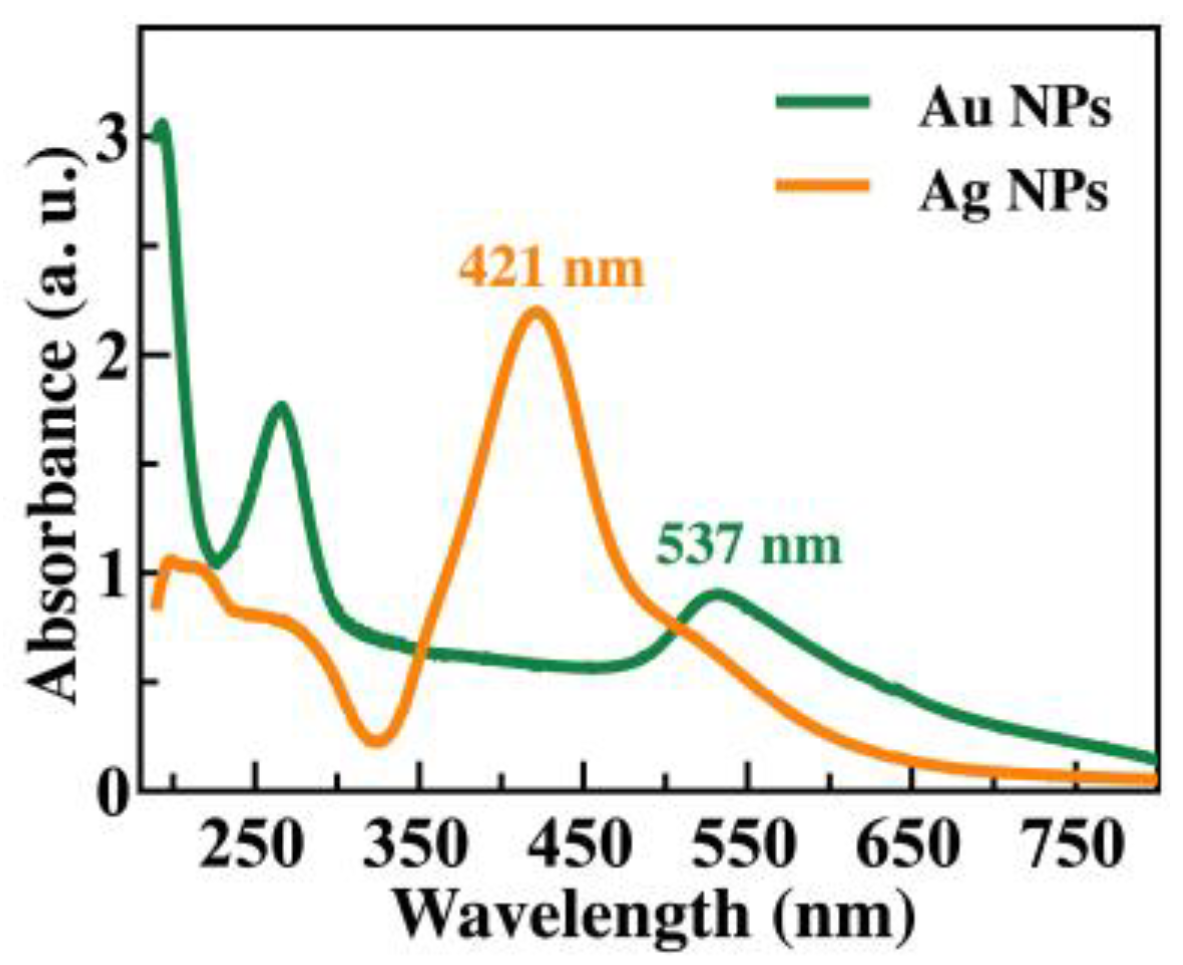
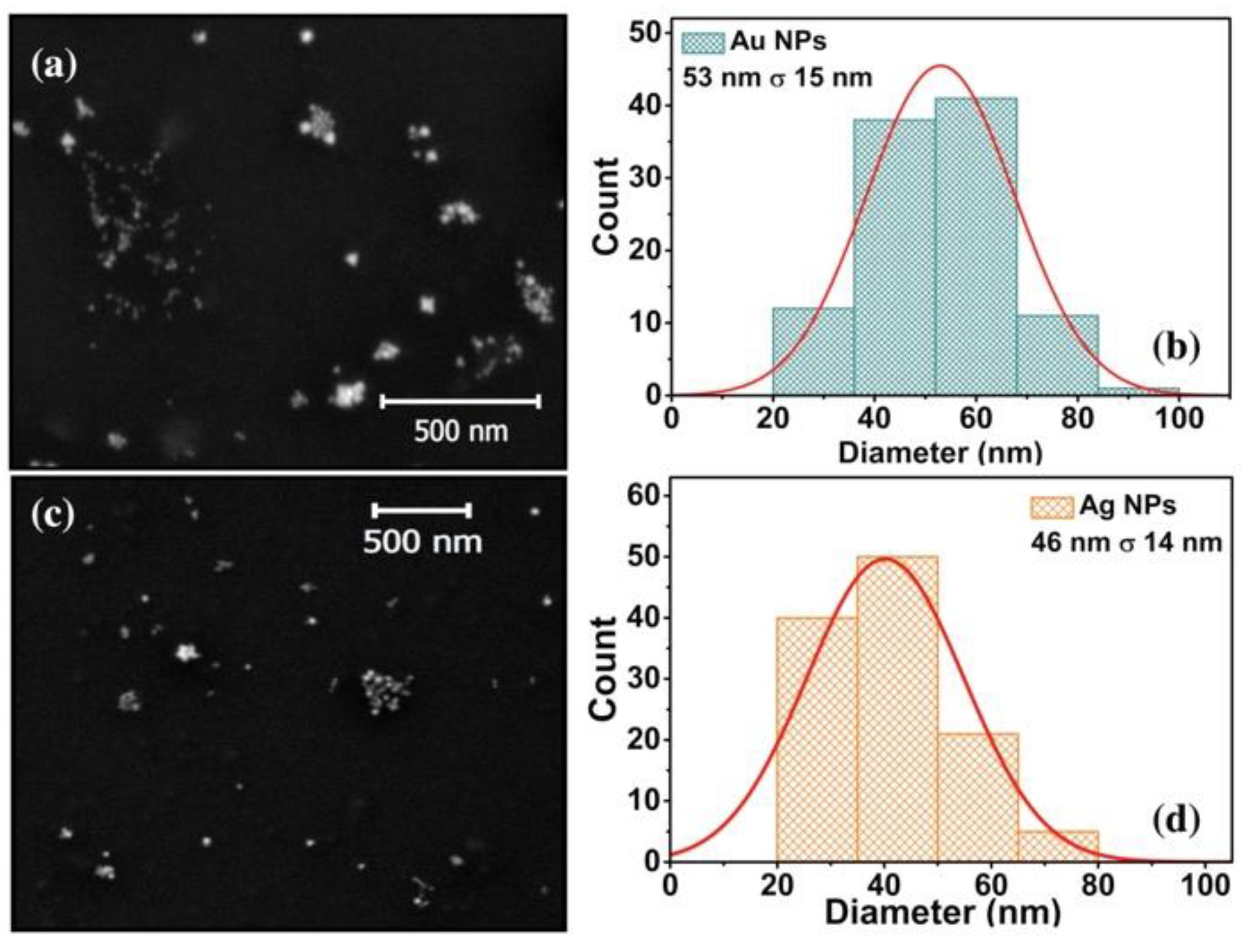

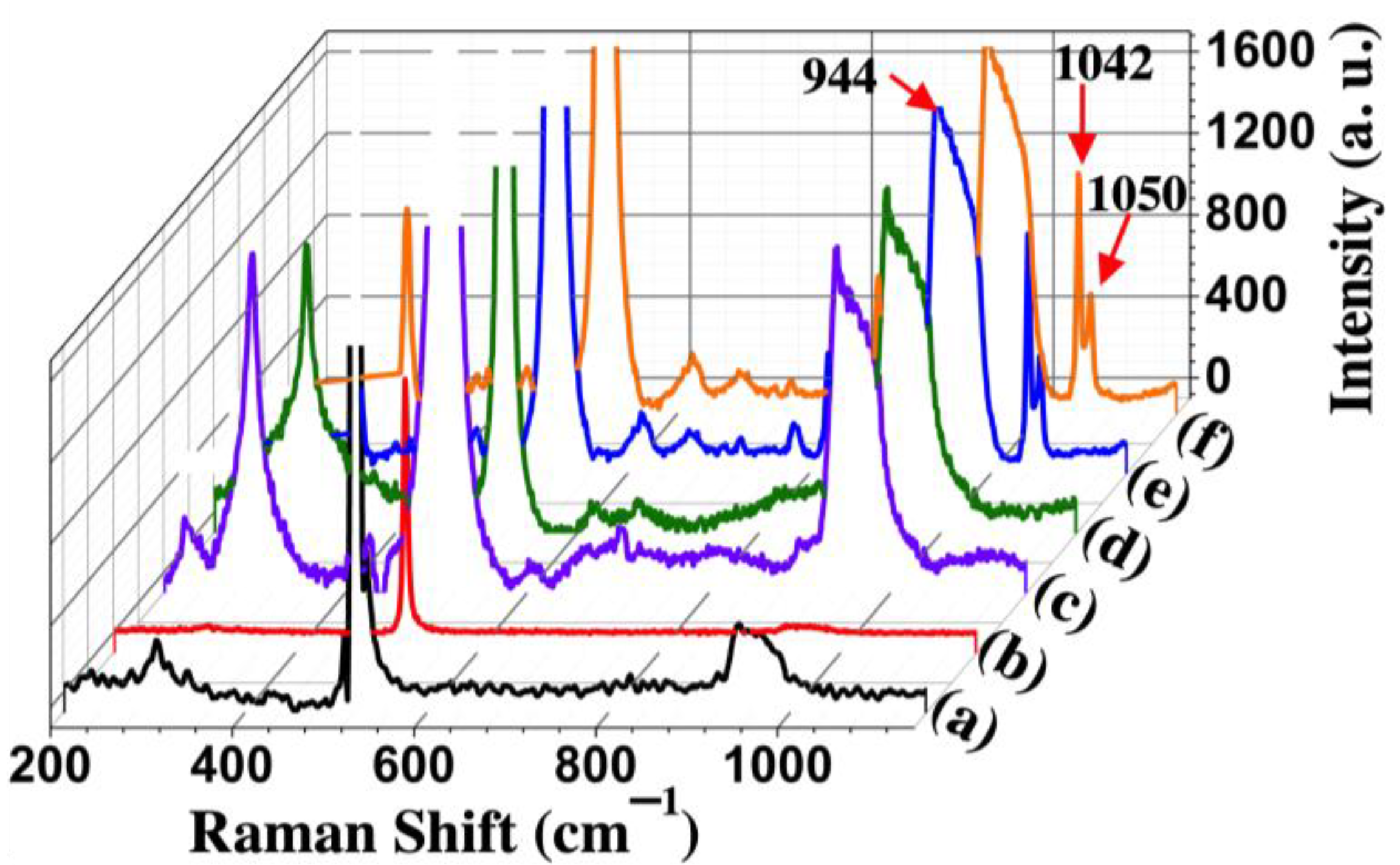
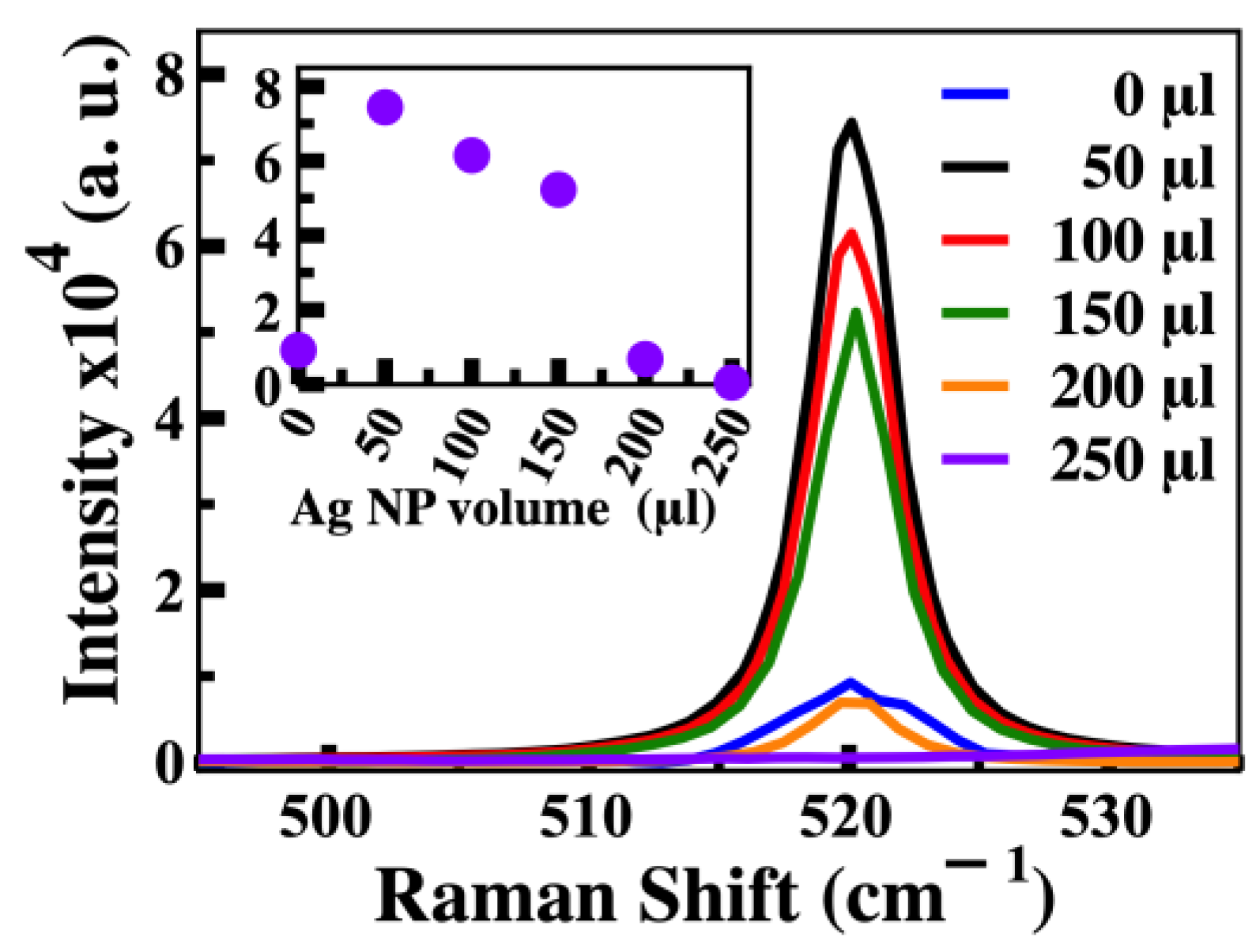
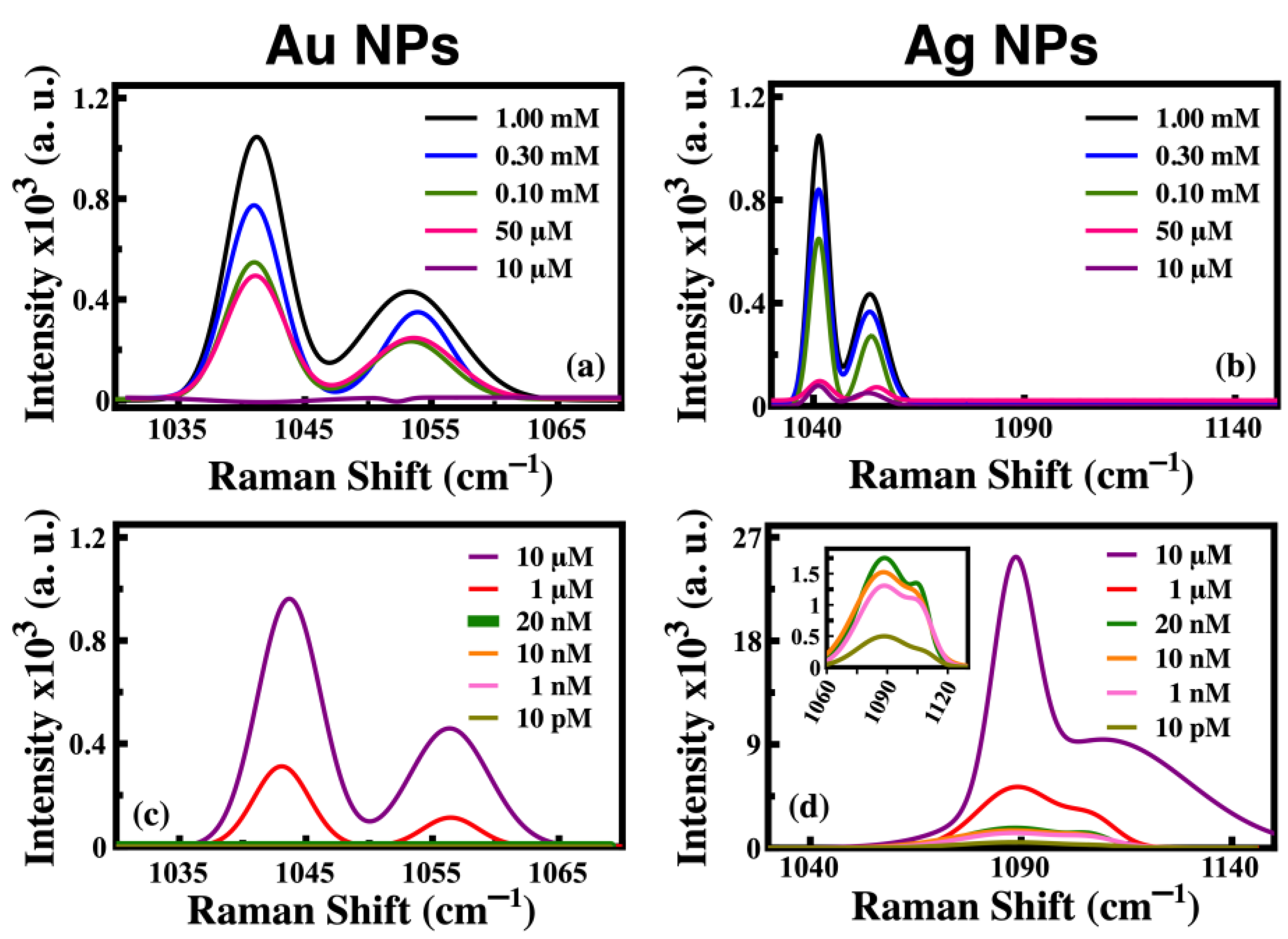
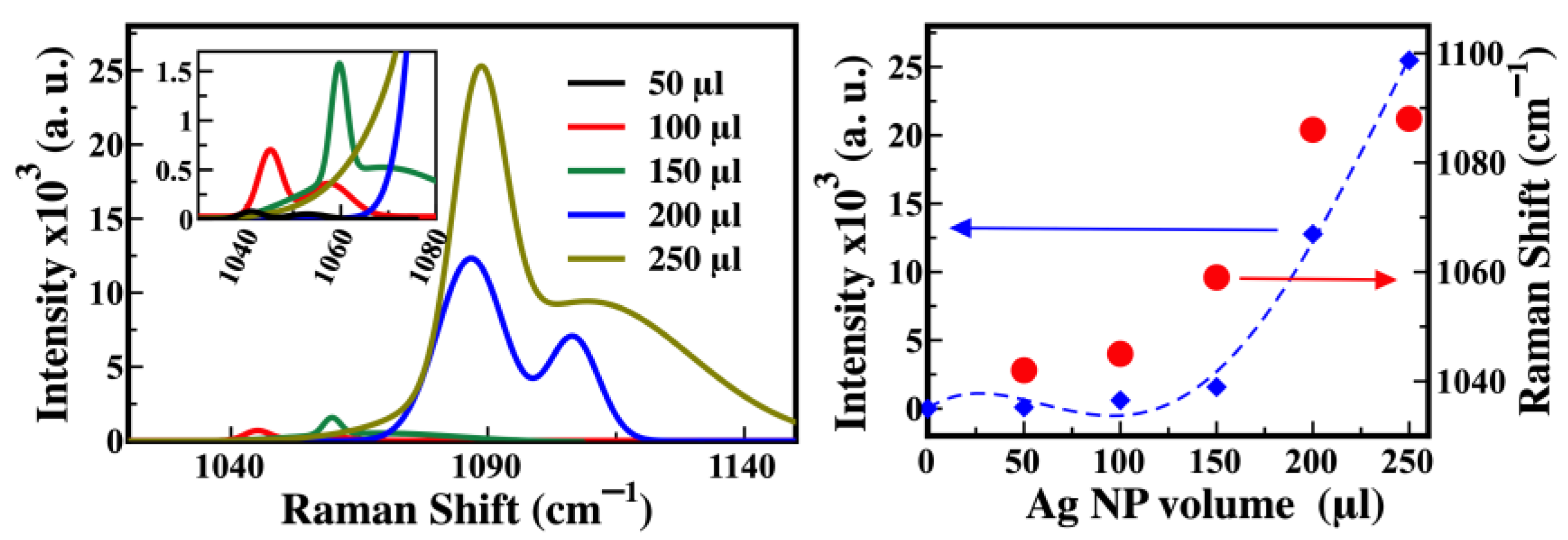

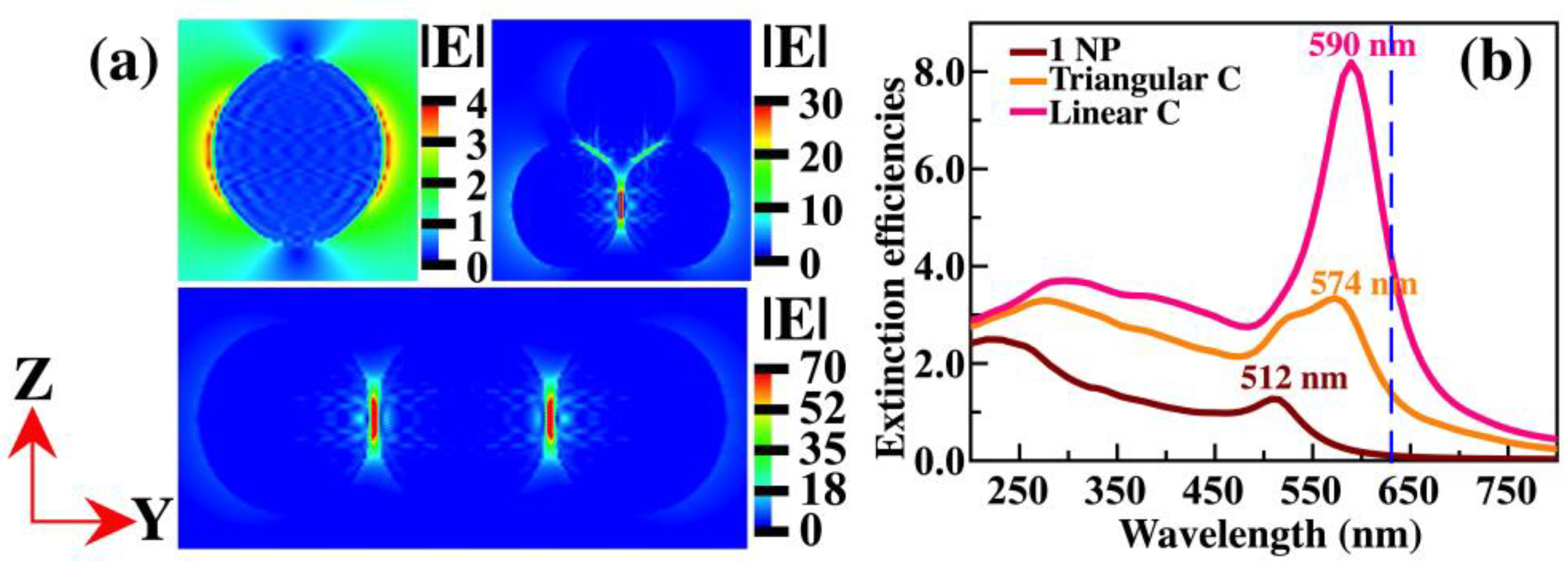
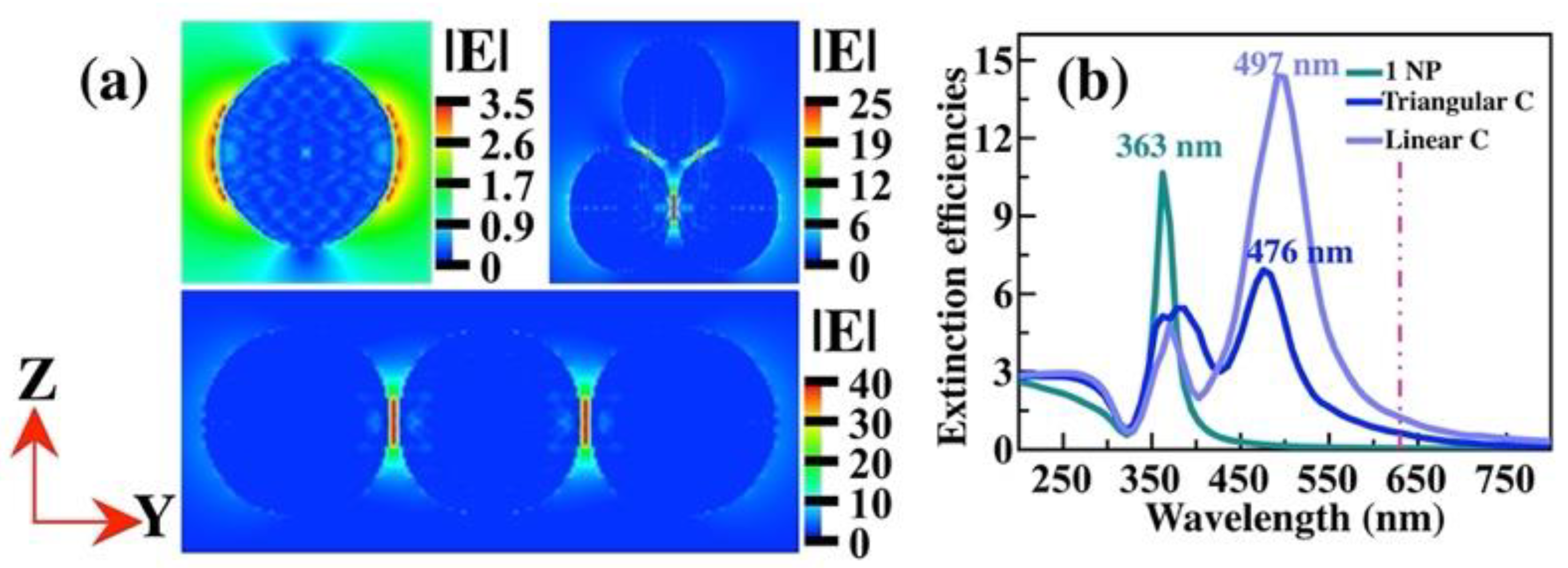
| Au NPs | |||||
| T4 Concentration | IRaman | ISERS | NRaman | NSERS | SERS-EF |
| 10 pM | 1 | 1 | 16.2 | 3.06 × 10−8 | 5.29 × 108 |
| 1 nM | 1 | 1 | 1.62 × 103 | 3.06 × 10−6 | 5.29 × 108 |
| 10 nM | 1 | 1 | 1.62 × 104 | 3.06 × 10−5 | 5.29 × 108 |
| 20 nM | 1 | 1 | 3.24 × 104 | 6.13 × 10−5 | 5.29 × 108 |
| 1 μM | 1 | 312 | 1.62 × 106 | 3.05 × 10−3 | 1.65 × 1010 |
| 10 μM | 1 | 962 | 1.61 × 107 | 3.05 × 10−1 | 5.08 × 1010 |
| 10 μM | 1 | 1 | 3.77 × 106 | 2.56 × 106 | 1.18 × 102 |
| 0.05 mM | 1 | 478 | 1.88 × 108 | 2.56 × 106 | 1.20 × 104 |
| 0.10 mM | 1 | 516 | 3.78 × 108 | 2.56 × 106 | 5.49 × 104 |
| 0.30 mM | 1 | 739 | 1.13 × 109 | 2.56 × 106 | 2.68 × 105 |
| 1.00 mM | 1 | 1022 | 3.78 × 109 | 2.56 × 106 | 2.20 × 106 |
| Ag NPs | |||||
| T4 Concentration | IRaman | ISERS | NRaman | NSERS | SERS-EF |
| 10 pM | 1 | 518 | 16.2 | 3.38 × 10−7 | 2.48 × 109 |
| 1 nM | 1 | 1318 | 1.62 × 103 | 3.38 × 10−5 | 6.30 × 109 |
| 10 nM | 1 | 1538 | 1.62 × 104 | 3.38 × 10−4 | 7.35 × 109 |
| 20 nM | 1 | 1787 | 3.24 × 104 | 6.77 × 10−4 | 8.54 × 109 |
| 1 μM | 1 | 5458 | 1.62 × 106 | 3.38 × 10−2 | 2.61 × 1010 |
| 10 μM | 1 | 25,481 | 1.61 × 107 | 3.37 | 1.22 × 1011 |
| 10 μM | 1 | 91 | 3.78 × 107 | 8.99 × 105 | 3.82 × 103 |
| 0.05 mM | 1 | 79 | 1.88 × 108 | 8.99 × 105 | 1.66 × 104 |
| 0.10 mM | 1 | 681 | 3.78 × 108 | 8.99 × 105 | 2.86 × 105 |
| 0.30 mM | 1 | 870 | 1.13 × 109 | 8.99 × 105 | 1.10 × 106 |
| 1.00 mM | 1 | 1073 | 3.78 × 109 | 8.99 × 105 | 4.52 × 106 |
Disclaimer/Publisher’s Note: The statements, opinions and data contained in all publications are solely those of the individual author(s) and contributor(s) and not of MDPI and/or the editor(s). MDPI and/or the editor(s) disclaim responsibility for any injury to people or property resulting from any ideas, methods, instructions or products referred to in the content. |
© 2023 by the authors. Licensee MDPI, Basel, Switzerland. This article is an open access article distributed under the terms and conditions of the Creative Commons Attribution (CC BY) license (https://creativecommons.org/licenses/by/4.0/).
Share and Cite
De Leon Portilla, P.; González, A.L.; Sanchez-Mora, E. Thyroxine Quantification by Using Plasmonic Nanoparticles as SERS Substrates. Chemosensors 2023, 11, 516. https://doi.org/10.3390/chemosensors11100516
De Leon Portilla P, González AL, Sanchez-Mora E. Thyroxine Quantification by Using Plasmonic Nanoparticles as SERS Substrates. Chemosensors. 2023; 11(10):516. https://doi.org/10.3390/chemosensors11100516
Chicago/Turabian StyleDe Leon Portilla, Paulina, Ana L. González, and Enrique Sanchez-Mora. 2023. "Thyroxine Quantification by Using Plasmonic Nanoparticles as SERS Substrates" Chemosensors 11, no. 10: 516. https://doi.org/10.3390/chemosensors11100516
APA StyleDe Leon Portilla, P., González, A. L., & Sanchez-Mora, E. (2023). Thyroxine Quantification by Using Plasmonic Nanoparticles as SERS Substrates. Chemosensors, 11(10), 516. https://doi.org/10.3390/chemosensors11100516







